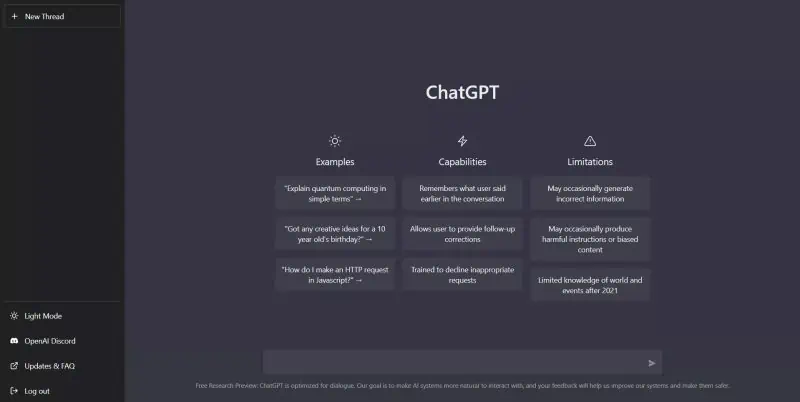What is ChatGPT?
OpenAI’s ChatGPT is an AI chatbot that burst onto the scene in November 2022, built on the powerful foundation of the GPT-3.5 and GPT-4 families of large language models (LLMs). Using supervised and reinforcement learning techniques, ChatGPT has been fine-tuned to provide detailed and articulate responses across a wide range of topics. While some have pointed to the bot’s uneven factual accuracy as a potential drawback, there’s no denying its impressive capabilities.
In fact, ChatGPT made such an impact upon its release that OpenAI’s valuation skyrocketed to $29 billion in 2023. And the bot’s potential is only growing: a version based on the latest GPT-4 model was made available on a limited basis to paid subscribers starting March 14, 2023.
Get ready to experience ChatGPT in a whole new way with ChatGPT Plus, powered by the groundbreaking GPT-4 model. This updated version not only boasts faster response times and support for more parameters but also provides more accurate answers to even the toughest questions, all while accepting visual input.
Also: Best ChatGPT Desktop Apps for Mac
But here’s the catch: ChatGPT Plus is currently only available to a limited number of users, and the only way to access it is by signing up for a $20 per month subscription (taxes included). If you’re eager to get your hands on this cutting-edge technology, you must fill out a form from OpenAI and join the waiting list.
So what can you expect from ChatGPT Plus? For starters, this multi-modal large language model responds to both text and images, making it even more versatile and powerful than its predecessors. You can even upload photos of your fridge contents and ask ChatGPT Plus for recipe suggestions based on what it sees in the pictures.
OpenAI put this model to the test on various benchmarks, including simulated human exams, and the results speak for themselves: ChatGPT Plus outperformed existing models across the board, whether dealing with well-known languages like English or more obscure ones like Welsh, Latvian, and Swahili. Get ready to experience the future of AI chatbots with ChatGPT Plus.
ChatGPT 4 vs ChatGPT 3

It was said that GPT-4 would have fewer parameters, at 175 billion, while still being able to generate text, translate languages, summarize text, and answer questions more quickly.
Since its release, GPT-4 has boasted faster and improved performance, but OpenAI has yet to disclose the exact number of parameters used in the model. This information seems to be kept under wraps for the time being, but we’re guessing this data will be released to the public soon enough.
GPT-4 also has the capability to process both text and image inputs and produce text outputs based on the given information. While visual input is still in its early stages, it has been shown to have similar capabilities as text-only input.
This is a significant upgrade from its predecessor, which was limited to only processing text inputs. With the ability to accept text and images, GPT-4 can generate natural language text outputs consistent with the inputs.
With its exceptional multitasking abilities, GPT-4 is poised to transform the way businesses rely on AI technology. This revolutionary model can handle several tasks simultaneously, making it an ideal choice for streamlining processes and increasing efficiency.
For instance, you can leverage GPT-4’s capabilities to automate customer service inquiries, effortlessly addressing multiple requests in a fraction of the time.
GPT-4 is a highly advanced language model that surpasses its predecessors in multiple ways. Unlike its predecessors, ChatGPT and GPT-3, which only respond to text input, GPT-4 is multi-modal, meaning it can understand more than one mode of information. It can not only process text but also take images as input and analyze them to provide relevant information. Furthermore, you can ask GPT-4 to explain the image in detail.
The ability to process multiple input types can prove to be incredibly useful for chatbots, as it can improve the user experience and provide a more engaging interaction. However, this feature is currently under development and limited in its capabilities.
It’s also worth noting that ChatGPT 4 is harder to trick, compared to its little brother. GPT-4 has been rigorously trained using various malicious prompts to improve its accuracy, steerability, and adherence to defined boundaries, surpassing its predecessors in these areas.
Last but certainly not least, ChatGPT 4 has a bigger memory, which is extremely important.
Language models such as GPT-3.5 are trained on vast amounts of text but have a limit on the amount of information they can remember during a conversation. This limit for the earlier version of ChatGPT is equivalent to four to five pages of a book, approximately 8,000 words or 4096 tokens. Beyond this point, the model may lose track of previous details as they recede further into its attention function.
However, with an impressive maximum token count of 32,768, GPT-4 has a greatly increased capacity. This allows the model to remember up to approximately 64,000 words or 50 pages of text, equivalent to a short story. GPT-4’s extended memory capacity provides it with the ability to recall past conversations, even if they occurred several pages back or more. While this explanation is a simplified approximation of the attention mechanism and token count, the underlying concept remains the same: GPT-4 possesses an advanced memory capacity and associated capabilities.














